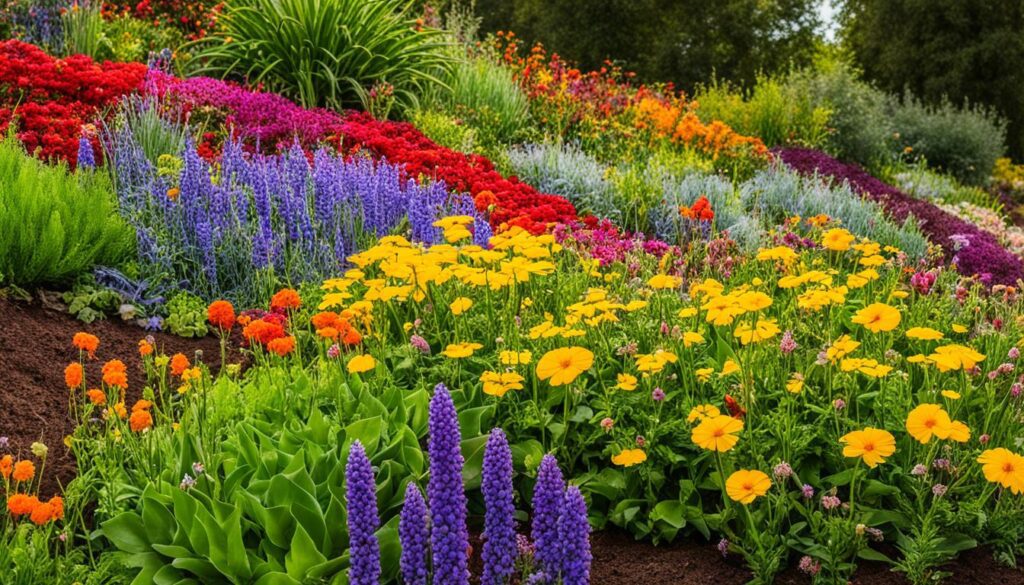
Are you struggling with poor yields and sickly plants? The key to a lush garden might be the soil below. Healthy soil is vital for a vibrant garden. It’s the base for a productive and strong garden. This soil is full of tiny organisms that help plants grow and use nutrients.
Gardening habits like too much tilling and using chemicals can harm the soil’s health. This can lead to problems for those working in the garden. Knowing the basics of soil makeup and how important its tiny life forms are can guide you. By taking simple steps to protect and support this hidden world, you can have a garden that’s full of life, resists disease, and grows well.
Practical Tips for Healthy Soil
Check your soil’s texture, color, and how much moisture it has. These traits tell a lot about your soil’s health. Healthy soil feels crumbly and light. It smells earthy. Dark brown to black soil means there’s a lot of organic matter. Good soil is moist, which helps the microbes live. Get to know your soil to see where it needs help.
Improve your soil by adding organic matter. Use things like compost, manure, or cover crops. Microbes in the soil will turn these into nutrients for plants. This makes the soil better for roots to grow. It also holds water and air well. Doing this helps your soil ecosystem stay healthy.

Minimize Soil Disturbance
No-till gardening is a way to not disturb the soil much. It’s great for the tiny living things in the soil, like bacteria and fungi. When we till the soil over and over, we break up the homes of these tiny life forms. This is bad for the soil and the plants. So, instead of tilling, we can plant without turning the soil over. This method keeps the soil healthy by not disturbing it. This way, helpful fungi and bacteria can live well, helping plants grow strong and use nutrients better.
Benefits of No-Till Gardening
No-till gardening helps the soil absorb water and air better. This means it can hold more water from rain or when we water it. Cover crops also help by stopping pests and making the soil more fertile. Not disturbing the soil much also means we use less fuel and work less. This saves both time and energy.
Preserving Soil Structure
A tiny bit of soil can have billions of tiny living things in it. These include bacteria, fungi, and even earthworms. The soil is made of things that are alive, things that were once alive, and very old things. Keeping the soil’s structure strong helps these tiny things live well. The soil’s structure is important because it makes room for air and water. This is where plants’ roots can grow. It also helps the good microbes do their job.

There are four basic rules for soil health: keep soil undisturbed, cover it with plants or their remains, promote variety, and have a living root as much as you can. Some believe there’s a fifth point: including grazing animals again. A living root in winter can help control erosion, provide food for grazing, and suppress weeds. Cover crops help with nutrient scavenging and fighting compact soil. They are especially helpful in winter, as they can grow easily in wet conditions, aiding in better growth for upcoming crops.
Root exudates play a big role in nutrient flow from soil to plants. Now, experts suggest the soil doesn’t need breaks and that cover crops have many benefits. These include using sunlight effectively, releasing exudates, and improving nutrient transfer. So, it’s very important to plant cover crops that last all winter. They trap sunlight, scavenge nutrients, stop soil erosion, help with soil compaction, and keep nutrient transfer smooth.
Incorporate Livestock for Soil Improvement
Adding animals like chickens, goats, or sheep to your garden helps the soil. Their poop and the way they walk flatten plants. This adds good stuff to the earth, feeding the tiny life in the soil. Their poop also brings helpful germs and nutrients from their guts. Their digging and eating help the ground get air and water, making a great place for soil life. This is a win for farmers because it makes the land more fertile and alive.
Old-style farms knew animals boost the land and used their waste wisely. These days, farms and animals are often far apart. But, letting animals graze helps the ground in many ways. It makes the soil richer, fights pests, and cuts down on weeding. This is great news for growing crops.

Conclusion
Cultivating a healthy soil microbiome is key for a great garden. Knowing the mix of microorganisms under the ground helps. It leads to better crops, less disease, and the garden coping well with tough conditions.
FAQ
What is the role of the soil microbiome in a healthy garden?
The soil microbiome is a network of tiny life forms. It boosts plant growth and keeps the soil healthy. It helps plants fight diseases and deal with tough conditions.
How can gardeners nurture a healthy soil microbiome?
One way is by adding organic material to the soil. Another is to disturb the soil as little as possible. Also, growing various types of plants helps a lot. Finally, always having live roots in the ground is key.
What are the benefits of a healthy soil microbiome?
A strong soil microbiome helps plants grow better. It also makes them healthier. This leads to more crops, water, and nutrients staying in the soil, and less harm from the environment.
How can gardeners assess the health of their soil microbiome?
They can look at the soil’s texture, color, and how wet it is. Healthy plants are also a sign the soil’s microorganisms are doing well.







